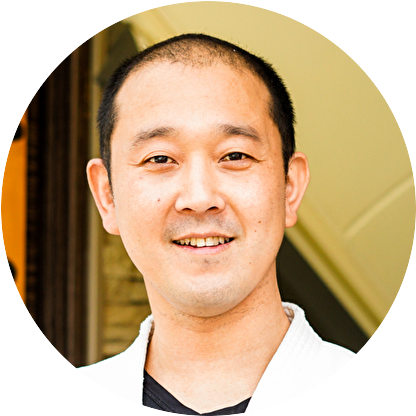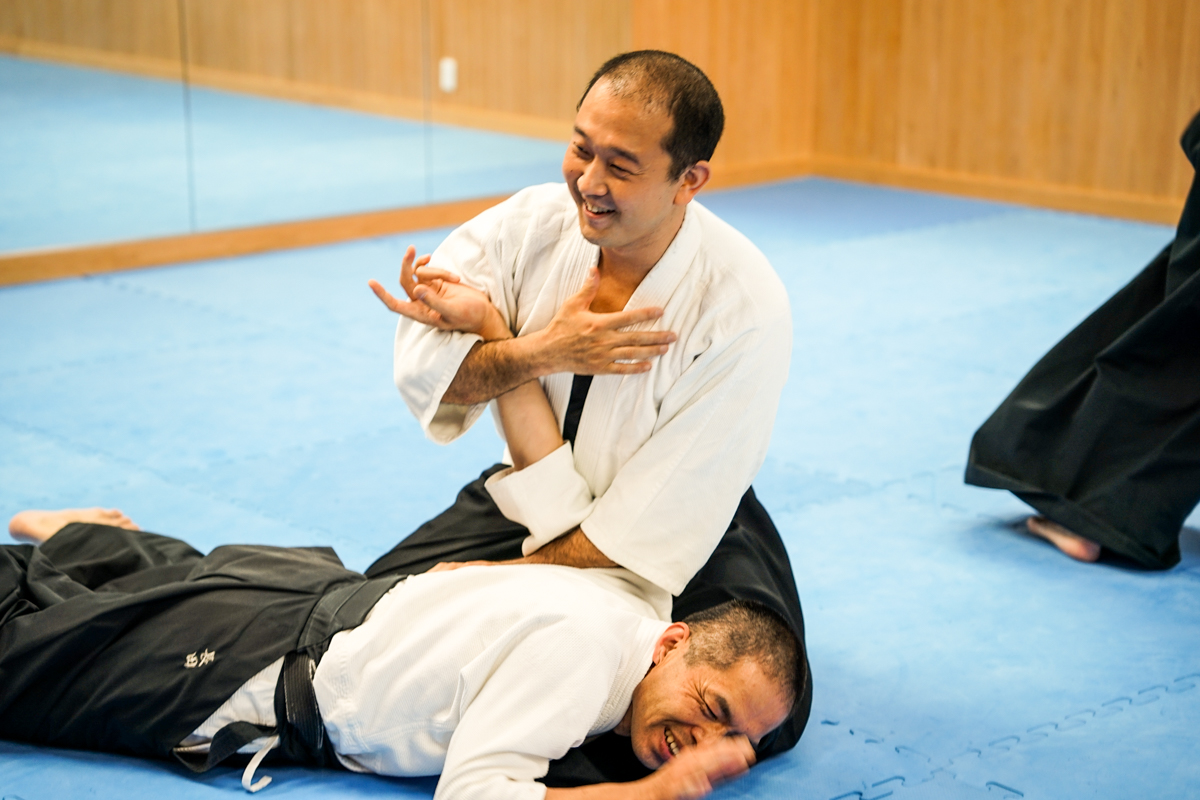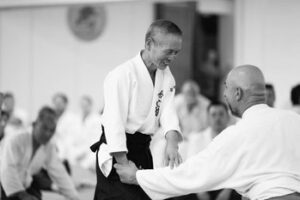
Hi, I’m Ogawa, the Dojo Chief. The article below is Pierre Fisie-san’s Interview on me. You can check original article(written in French) form here.
Thank you so much, Pierre-san!
My name is Pierre Fisie. I am a student of Philippe Monfouga, who is a disciple of Philippe Gouttard.
Through my website, Aiki-Kohai, I aim to spread Aikido, especially to beginners, and share my knowledge. I also enjoy learning from other teachers such as Bernard Palmier, Philippe Gouttard, Didier Boyet, and stay in contact with other instructors.
Q: Ogawa Sensei, please tell us about your first training. When and why did you start Aikido?
Ogawa: I remember starting Aikido around the end of my first year in high school. Actually, it took almost a year from when I wanted to practice martial arts until I started Aikido.
I was extremely shy, and due to my difficulty in expressing myself verbally, combined with being in adolescence, I struggled and developed autonomic imbalance. I felt sluggish and tired all the time, and I became somewhat pessimistic about the future.
At that time, a friend introduced me to the book of Masahiro Yanagawa-Sensei , who was practicing karate despite having a weak constitution and various illnesses. Reading that book inspired me to pursue martial arts.


However, lacking the confidence to immediately join a dojo, I started by imitating what I read in the book every day, training my body and doing things similar to karate. That was my first martial arts practice.
After continuing for a while and gaining physical strength and confidence, I considered doing karate. It turned out that the friend who introduced me to the karate book was secretly practicing Aikido. Without telling anyone, I started attending the dojo with that friend, and that’s how I encountered Aikido.
Q: When you were still a student of Aikido, what aspects of training were challenging for you? What was easy? Which exercises did you like? Who was your teacher at the time?
Ogawa: My first Aikido teacher was Sensei Kudota, 8th dan, from Nara Aikikai. In university, I learned from Sensei Morita of Osaka Buki-kai and from senior students and alumni in the club.
What was challenging for me, or rather, what was difficult, was that even within the same organization, instructions and teachings from different leaders and teachers could vary significantly.
As I mentioned earlier, I started Aikido in high school, but when I joined the university club, I had to start from scratch and relearn techniques. Instructions from Sensei Kudota were quite different from what I had learned previously (for example, he taught me to extend the fingers of my hand, while Sensei Kudota emphasized relaxing the fingers). I was quite confused.
Now, I understand that these were superficial issues and that internally, all these teachings were valid, but at the time, being young and immature, I felt resistance and insisted on my own way. I was weak and unskilled, yet… (laughs)
Such experiences have led me to be quite specific in defining the forms of basic techniques in Aikido Kyoto to prevent confusion among beginners. I’ve always emphasized correct posture in training since my youth.
Although I never thought Aikido was easy, I was always particular about maintaining proper posture during practice. I have liked training that involves consciousness of the hara (abdomen) and axis since the early days.


Q: Do you have any pursuits through Aikido? If so, are you getting closer to what you aim for through Aikido practice? How did you decide to continue practicing Aikido?
Ogawa: I have great respect for my teacher, Master Tanimoto. Currently, I try not to emphasize my own preferences too much and keep my mind blank to learn Aikido from Master Tanimoto.
Just like the quiet surface of a lake reflecting the moon.
Originally, I didn’t have a strong consciousness of pursuing Aikido as a martial art. I am strongly drawn to the aspect of Aikido that cleanses the mind, called misogi in Japan.
Whether I am growing in that direction, I don’t know myself. I just believe that by practicing hard, I will naturally progress in that direction.
The reason I have been able to continue Aikido until now and will continue in the future is because there was a great teacher, Master Tanimoto.
Both in terms of technique and the spiritual aspect, he has an incredible depth of knowledge and continues to grow at an astonishing speed.
In the pursuit, I have just diligently practiced Aikido without realizing it for a long time.
Q: Why did you choose Aikido Kyoto?
Ogawa: At first, it wasn’t a choice; it was the only option.
After graduating from university, I got a job, and although I wanted to work in the Kansai region, I unexpectedly ended up working in Ehime Prefecture. At that time, there was only one dojo within reach, which was a branch dojo of Aikido Kyoto.
Later, I returned to Kansai due to a job transfer, but I really wanted to practice Aikido under Tanimoto-sensei, so we established Aikido Kyoto ourselves.
Tanimoto-sensei’s technique has something that I feel there is no alternative to for me.
My hand doesn’t separate from the technique, and I can’t stand? after being thrown. Even when thrown, there is no unpleasant feeling; instead, it feels like a mysterious sensation, and the person thrown often laughs.
I can’t express it in one word, but intuitively, I had a conviction that this is the only thing I should practice in Aikido.
Q: Can you tell us about the first time you met Tanimoto-sensei?
Ogawa: When I joined the dojo after getting a job, it happened to be a branch dojo of Aikido Kyoto, and Master Tanimoto visited once a month for instruction.
After going to practice several times, there was a day when Tanimoto-sensei had an instructional day.
As usual, I went to practice, and in the corner of the dojo, a small middle-aged man was sitting in seiza. I didn’t know that person was Tanimoto-sensei, but…
His sitting posture, it’s hard to put it into words, but like the axis extending between heaven and earth, an incredibly refined intensity. I trembled at the overwhelming power even before seeing him perform any technique.
When the practice started, it was a sight I had never seen in any previous practice.
Tanimoto-sensei was executing techniques with tremendous force. Although he didn’t show any strength, uke (the person receiving the technique) fell with tremendous force.
At first, I thought it might be something like a mental thing, but the people receiving the technique were usually very strong and came at full force, so it was a strange feeling. I couldn’t believe that such a thing could be accomplished with just intention.
That day became the most shocking day of my life.
It felt like being hit on the head with a hammer. I didn’t know what was happening, but I wanted to know more! That was my impression when I met Tanimoto-sensei for the first time.
From there, I bought a car, and whenever there was a day off, I spent one and a half hours one way to attend Tanimoto-sensei main dojo. I decided to imprint that sensation in my body by receiving throws from him as much as possible, given that I was going to be transferred in three years.
I attended practice diligently, and my weekends always ended exhausted. It was a limited time, so I was desperate.


Q: Are there other teachers you are interested in?
Ogawa: Second Doshu Kisshomaru Ueshiba. To be frank, when I was young, I didn’t like Kisshomaru Sensei’s Aikido. He always spun around, and there was no intensity in his techniques like shouting “Ei!” It didn’t look cool, that was my honest impression as a young person.
However, I heard the following story from Master Tanimoto:
When Master Tanimoto was still young, Kisshomaru Sensei came to Matsuyama. Because Master Tanimoto was young and full of energy, he clenched his sides with a companion, thinking, “There’s no way I’ll be thrown so easily,” and they went to grab Kisshomaru Sensei’s arms with all their might.
However, in the next moment, as if the strength was being sucked out, they were thrown effortlessly, without any resistance. Master Tanimoto couldn’t forget the feeling of Kisshomaru Sensei’s hands, and he studied it on his own.
After hearing this story, I often watch videos of Kisshomaru Sensei. Kisshomaru Sensei is the most interesting teacher for me.
In some videos, especially from my teachers (especially Kenji Kobayashi: a junior from the Aikido club at Kansai Gakuin University), they say that your techniques and seated techniques during practice are very impressive.
Q: In France, seated techniques are considered very difficult, but why do you think French Aikido practitioners consider it difficult?
Ogawa: Perhaps even though it’s not as much as before, there are still many opportunities in Japan from childhood to sit in seiza as part of daily life. Also, since I think seated techniques require moving from the hips to be quick, Japanese people are often told to engage their hips when doing sports or exercises, which might have some influence.
However, I believe that if you practice, both French and Japanese people will improve equally.
Regarding Aikido ukemi (receiving techniques), what do you think? What role do you think it plays?
I believe that in Aikido, both performing techniques (tori) and receiving techniques (uke) should be practiced together. Just like breathing, it’s like you can’t survive by just exhaling or inhaling.
When performing a technique, you emit power from your center (axis or tanden). On the other hand, when receiving, you firmly accept your partner’s power at the center.
In terms of analogy to breathing, performing a technique is like exhaling, and receiving is like inhaling.
Receiving is not only about protecting yourself; it’s also about creating a body that is firmly centered and flexible. Recently, I think that a connection with the partner is cultivated while receiving techniques.
Therefore, I always try to practice tori and uke as a set. Both are important practices. In the words of Tanimoto-sensei, “Aikido cannot be explained. If it can be explained, the only thing is to use your body to the fullest.”
You can do techniques with tori using tricks, but for uke, you have to use your whole body.
Tanimoto-sensei actively takes ukemi from his students. I also want to continue taking firm ukemi no matter how old I get.
Q: In France, various effects of Aikido are said to exist (for example, being able to take ukemi when attacked on the street). What do you think?
Ogawa: I am not particularly interested in the practicality of Aikido in fights or self-defense. So, I feel a little uncomfortable when called a martial artist.
As I mentioned earlier, I was a dropout, so I feel joy when members come to practice saying it’s fun, they made many new friends through Aikido, or they got a girlfriend through Aikido (laughs).
I feel joy when members become happy through Aikido practice.
“If practicing Aikido does not lead to the happiness of that person’s life, it is meaningless.”
This is a phrase that was often taught to me by Katsuki Nakamura Sensei (8th dan) from Yamaguchi Prefecture during my time in Ehime. This phrase deeply pierces my heart.
Therefore, our activities are based on the philosophy of enriching the lives of as many people as possible through Aikido.
It’s a bit off-topic from the question, but that’s what I think.


Q: Some instructors say that the way we currently use techniques and our bodies is different from the way the old instructors did. What are your thoughts?
Ogawa: I don’t have much attachment to the visible form of techniques or the detailed interpretations of specific forms. Rather, I think issues within the body, such as the axis, tanden, and respiratory power—things that are not visible—are crucial.
While there may be differences between the techniques of the old teachers and the style we are practicing today, I believe that the truly important aspects, the invisible elements, can be integrated into our style.
Instead of being deeply attached to visible differences in the style of techniques, I believe it would be good for everyone to respect various styles and collectively polish the invisible aspects.
Q: Why did you decide to teach Aikido?
Ogawa: I don’t have a sense of being an Aikido instructor. I consider my most important role to create a place where many people can enjoy practicing Aikido. Within that context, I feel like I am practicing together with everyone.
I always want to practice at the same eye level as everyone else. Of course, when guidance is needed, I will guide with all my heart.
The reason for creating Aikido Kyoto was, first and foremost, because I wanted to practice Aikido at Aikikai. Secondly, I wanted as many people as possible to know about Master Tanimoto’s Aikido. Opening a dojo in Kansai had significant meaning in achieving that goal.
Q: What advice do you have for beginners starting Aikido?
Ogawa: Practice with a smile, without wrinkling your forehead or thinking too seriously. If you come to love Aikido, the technical skills will naturally follow.
My number one job is for beginners to enjoy and come to love Aikido. I believe that this will lead to their greatest improvement rather than giving them detailed guidance.
Q: I heard that you also teach in Osaka. Do you have any future plans for the club? In France, you are welcomed and liked, I think.
Ogawa: To realize the dojo’s philosophy of enriching as many people’s lives as possible through Aikido, we will focus on increasing the number of members for now. Although I have a clear vision for the future, I can’t write everything here. I want to steadily move forward toward realizing that vision.
Thank you. I would love to practice in France as well. Aikikai has branches in Italy, so after visiting Italy someday, I’d like to visit France too.
*Several years later, a seminar in Paris was realized, and I had the opportunity to meet Pierre-san (^_^)


(Note) In this interview from several years ago, I made some embarrassing remarks, and my thoughts were less mature. Some of my current views may have changed a bit.



コメント